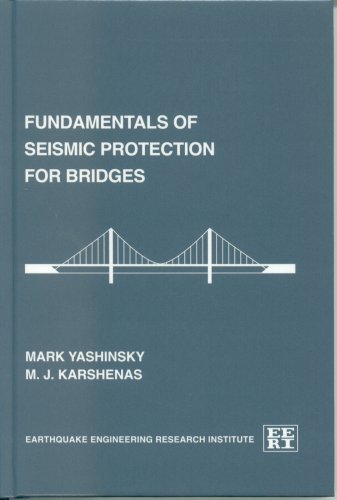Items related to Fundamentals of seismic protection for bridges (Engineering...
Fundamentals of seismic protection for bridges (Engineering monographs on earthquake criteria, structural design, and strong motion records) - Hardcover

"synopsis" may belong to another edition of this title.
M. J. Karshenas is employed in the Bridges and Structures Bureau, Division of Highways, Illinois Department of Transportation.
Bridges are different from buildings and other kinds of structures. They are long and narrow, often with considerable distance between supports. The entire bridge is exposed to the environment and may receive minimal maintenance. Unlike buildings, bridges support a fleeting populace. Unless bridges are very long or visually striking, travelers may not even notice that they are crossing over a bridge. Most bridges are owned by public highway departments or by private railroads. One such organization can own thousands of bridges. Bridges are constructed from steel, reinforced concrete, timber, masonry, composites, or a combination of these materials.
The bridges in a particular region are determined by the obstacles that must be crossed, availability of materials, construction expertise, climate, and loads that must be carried. Bridges may support highways or railways, or they may carry gas lines, water lines, and other utilities. They often support a combination of lifelines.
Although this monograph examines bridges in general, its emphasis is on highway structures. Every year, the state transportation departments send the Federal Highway Administration (FHWA) a database that describes bridges that are on public roads. The FHWA then creates the National Bridge Inventory (NBI), a database that lists highway bridges for each state; the NBI organizes bridges by structural type, material, and deficiency.
The live load on a bridge may dictate the choice of material and the type of load-carrying system. For instance, steel through-girder superstructures are often used for railroad bridges. Another factor in selecting the material and structural type is span length. A bridge with short spans (6-18 meters) may be built with timber girders or with a concrete slab superstructure, whereas a bridge with medium spans (18-90 meters) is often built with steel girders, precast concrete girders, or cast-in-place box
girders. Longer spans (90-300 meters) may have truss or arch superstructures, whereas the longest bridges (> 300 meters) are cable-stayed or suspension structures.
The glossary in Appendix A defines terms that pertain to bridges and bridge elements.
Bridges consist of two structural components: a superstructure that includes the elements above the supports and a substructure that includes elements that support the superstructure (Figure 1).
The design of short-to-medium-span bridges is specified by a number of codes. The design of U.S. highway bridges is slowly transitioning to the Load and Resistance Factor Design (LRFD) Bridge Specifications (AASHTO 1998). U.S. railway bridges are designed according to the provisions of the American Railway Engineering and Maintenance-of-Way Association (AREMA) Manual (AREMA 2002). European bridges are designed according to the sections in the Eurocode that pertain to bridges. Some nations or bridge owners may have their own bridge specifications, whereas others may use the most applicable available code. For instance, light-rail bridge owners may use the relevant parts of the LRFD Bridge Specifications and the AREMA Manual.
Bridges are simple structures that are often dominated by a single mode of vibration in the longitudinal and the transverse direction. However, the longitudinal and
transverse behavior of bridges can be quite different, particularly for long, narrow bridges. Consideration of a bridge's longitudinal and transverse load paths is of great importance in understanding its behavior during earthquakes.
The vast majority of bridges have short-to-medium spans. Such bridges can be categorized as premanufactured girder bridges or as monolithically constructed, cast-in-place girder bridges. During an earthquake, the longitudinal and transverse load-carrying systems of premanufactured and cast-in-place girder bridges function differently. For instance, bent caps are part of the substructure of premanufactured girder bridges, whereas they are usually part of the superstructure in cast-in-place girder bridges (Figure 1). This means that, during an earthquake, the cast-in-place superstructure can resist the longitudinal and transverse column moments in shear and bending, whereas the premanufactured girder bridge must rely on the dropped bent cap or on special devices to transfer the seismic forces between the substructure and superstructure.
"About this title" may belong to another edition of this title.
- PublisherEarthquake Engineering Research Institute
- Publication date2003
- ISBN 10 0943198046
- ISBN 13 9780943198040
- BindingHardcover
- Number of pages184
Buy New
Learn more about this copy
Shipping:
US$ 4.00
Within U.S.A.
Top Search Results from the AbeBooks Marketplace
Fundamentals of seismic protection for bridges (Engineering monographs on earthquake criteria, structural design, and strong motion records)
Book Description Hardcover. Condition: new. New. Fast Shipping and good customer service. Seller Inventory # Holz_New_0943198046
Fundamentals of seismic protection for bridges (Engineering monographs on earthquake criteria, structural design, and strong motion records)
Book Description Hardcover. Condition: new. New. Seller Inventory # Wizard0943198046
Fundamentals of seismic protection for bridges (Engineering monographs on earthquake criteria, structural design, and strong motion records)
Book Description Condition: new. Seller Inventory # FrontCover0943198046
Fundamentals of seismic protection for bridges (Engineering monographs on earthquake criteria, structural design, and strong motion records)
Book Description Hardcover. Condition: new. New Copy. Customer Service Guaranteed. Seller Inventory # think0943198046

